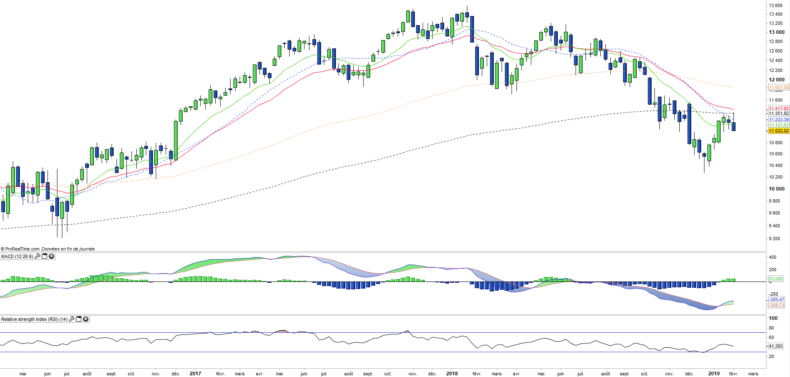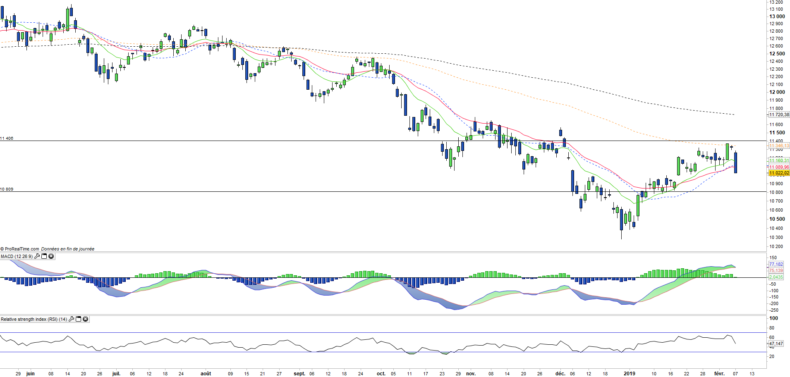Lyxor DAX - DAX - 08/02/19
Short Term strategy: Negative (40%) / Trend -
Long Term strategy: Negative (5%) / Trend -
pour accéder à nos achats / ventes sur les indices
Characteristics of the ETF
The DAX ETF (Lyxor), quoted in Euro, replicates the DAX 30 index which is composed of the 30 largest listed German securities, representative of the main sectors of the economy, while the stocks are selected according to the importance of their market capitalization.
The costs of this ETF are low at 0.15% and AUM is quite high at 850M €, which makes it a good vehicle in terms of costs / liquidity. The replication method is direct (physical) and the dividend distribution is capitalized.
Alternative ETFS: DBXD (DB-x Tracker in Euro), DAXEX (iShares in Euro)
Index & components
The top 10 stocks are mainly large industrial stocks such as Siemens or Bayer, while there are only 3 financial stocks: Allianz, Commerzbank and Deutsche Bank, the German master index is relatively small and mostly composed of large industrial groups.
Unlike the English, French or Italian indices, the DAX is also distinguished by the absence of large oil companies that weigh heavily in the weighting of the CAC40, FTSE100 or FTSEMIB40, which is double-edged according to the cycle specific to energy sector. In addition, the financials weigh only 15% of the index, half for the insurance giant Allianz, so the banking sector has a low weight reflected in the well-known weakness of Deutsche Bank and Commerzbank. Conversely, the automotive and chemical sectors are heavier than the other European indices, while the technology sector is mainly represented by SAP (10%) whose market capitalization exceeds € 100 billion.
In summary, the DAX is a fairly strong index from a sectoral point of view which can make it evolve differently from other European indices.
German fundamentals are very solid (historically low unemployment rate at 5.5% and accelerated deleveraging up to 2020). The main risks concern Germany's main customers, namely the United Kingdom, which could suffer from Brexit, the US in political uncertainty and threatening it with a trade war, Russia which remains a difficult and aggressive neighbor and China because of its commercial practices which also tend to limit access to its domestic market to Western industrialists, particularly in the automotive and technology sectors.
Latest developments
After an increase of 6.9% in 2016, the DAX30 grew by 12.5% in 2017, more than the stoxx600 (+ 10.6%). But the index fell by 18.5% in 2018, which is a much lower performance than the Stoxx600NR (-10.7%). The DAX starts a rebound since the beginning of the year (+ 4.4%) which seems very fragile. This poor performance reflects the large share of cyclical stocks (chemicals, autos, equipment goods) in the index and the exposure to international trade endangered by the US protectionist attitude and fears over the Chinese growth on which German companies are increasingly dependent.
The weakening of the Chinese economy and in particular the automotive sector is a matter of concern for the German industry, which is almost in recession.
Weekly data
On the weekly chart, we can see that the threat of a bearish recovery is gaining momentum after a rebound phase of several weeks. This bearish attack crosses the EMA13 and could quickly signify a return to the recent lows in case of deeper decline. The weekly closing session will therefore be important because it could send a negative signal on the DAX if confirmed.
Daily data
The daily chart shows the failure of the rebound on the EMA100 which resulted in the formation of a bearish attack in the form of a large black candlestick. The resume of the decline must however be confirmed in the coming days, for the signal to be effectively launched, a negative crossing of the EMAs13 & 26 will be required, coupled with the continuation of the decline with an intensity comparable to the day's session.
Theme
DAX is a UCITS ETF, listed in EUR, which seeks to replicate the German DAX index (30 companies)
Characteristics
| Inception date | 01/06/2006 |
| Expense ratio | 0,15% |
| Issuer | Lyxor |
| Benchmark | DAX 30 index |
| Code/Ticker | DAX |
| ISIN | LU0252633754 |
| UCITS | Yes |
| Currency | € |
| Exchange | Euronext |
| Assets Under Management | 847 M€ |
| Replication Method | Direct (Physical) |
| PEA (France) | Yes |
| SRD (France) | Yes |
| Dividend | Capitalization |
| Currency risk | No |
| Number of Holdings | 30 |
| Risk | 3/5 |
Country Breakdown
| Germany | 100% |
Sector Breakdown
| Materials | 18% |
| Consumer Discretionary | 16% |
| Financials | 15% |
| Information Technology | 14% |
| Industrials | 12% |
| Health Care | 12% |
| Communication Services | 5% |
| Others | 8% |
Top Ten Holdings
| SAP | 10% |
| Siemens | 9% |
| Allianz | 8% |
| Linde | 8% |
| Bayer | 7% |
| BASF | 6% |
| Daimler | 5% |
| Deutsche Telekom | 5% |
| Adidas | 4% |
| Muenchener Rueckver | 3% |


